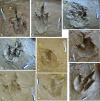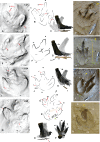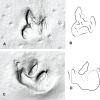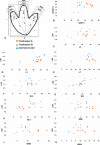A methodology of theropod print replication utilising the pedal reconstruction of Australovenator and a simulated paleo-sediment
- PMID: 28603673
- PMCID: PMC5463970
- DOI: 10.7717/peerj.3427
A methodology of theropod print replication utilising the pedal reconstruction of Australovenator and a simulated paleo-sediment
Abstract
Distinguishing the difference between theropod and ornithopod footprints has proved a difficult task due to their similarities. Herein our aim was to produce a method where a skeleton could be more closely matched to actual fossilised footprints. The reconstructed pes of the Australian Megaraptoran Australovenator wintonensis was utilised for this footprint reconstruction. It was 3-D printed in life size, molded and cast to produce a flexible theropod foot for footprint creation. The Dinosaur Stampede National Monument, Lark Quarry, Queensland, Australia was used as our case study to compare fossilised dinosaur footprints with our reconstructed theropod prints. The footprints were created in a sediment that resembled the paleo-sediments of Lark Quarry prior to being traversed by dinosaurs. Measurements of our Australovenator prints with two distinctly different print types at Lark Quarry revealed similarities with one distinct trackway which has been the center of recent debate. These footprints consist of 11 consecutive footprints and show distinct similarities in both size and proportions to our Australovenator footprints.
Keywords: Australovenator; Lark Quarry; Megaraptorid; Theropod; Trackway.
Conflict of interest statement
The authors declare there are no competing interests.
Figures









References
-
- Cuesta E, Diaz-Martinez I, Ortega F, Sanz JL. Did all theropods have chicken-like feet? First evidence of a non-avian dinosaur podotheca. Cretaceous Research. 2015;56:53–59. doi: 10.1016/j.cretres.2015.03.008. - DOI
-
- Falkingham PL. Interpreting ecology and behaviour from the vertebrate fossil track record. Journal of Zoology. 2014;292(4):222–228. doi: 10.1111/jzo.12110. - DOI
-
- Falkingham PL. Applying objective methods to subjective track outlines. In: Falkingham PL, Daniel M, Richter A, editors. Dinosaur tracks the next steps. Bloomington: Indiana University Press; 2016. pp. 72–80.
-
- Gatesy SM. Skin impressions of Triassic theropods as records of foot movement. Bulletin of the Museum of Comparative Zoology. 2001;156(1):137–149.
LinkOut - more resources
Full Text Sources
Other Literature Sources
Miscellaneous

